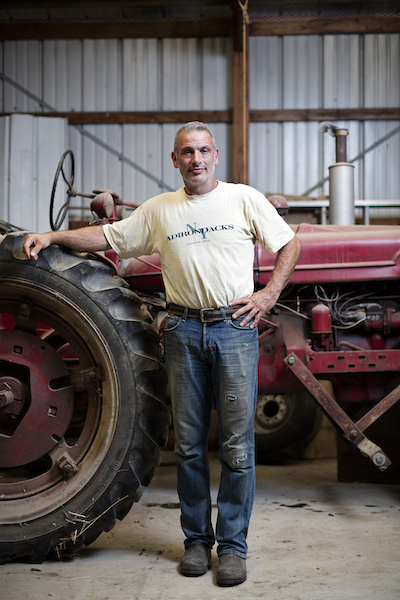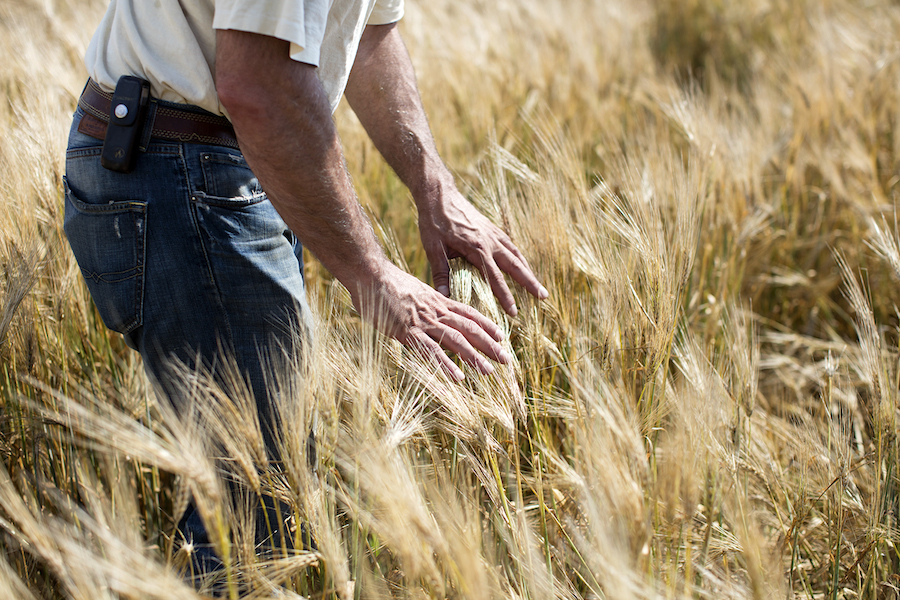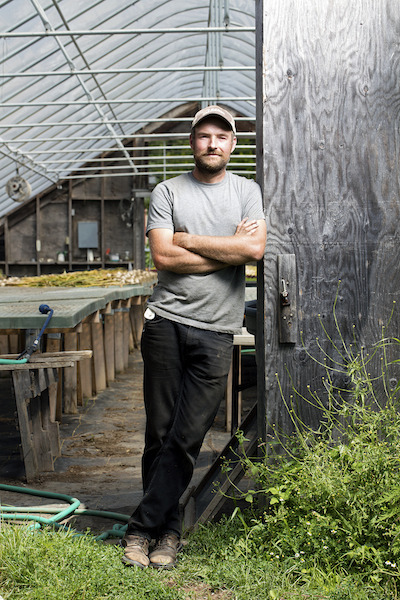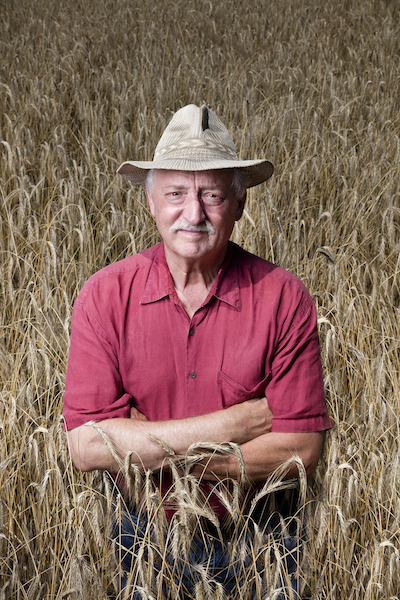Despite its pivotal role in helping create civilization, wheat has had a tough go of it for the last few years. Diet fads espousing carb-free or caveman-like eating have inspired millions to say no to the bread basket and quit pasta altogether. Gluten has become public enemy number one to many who blame it for their digestive problems—and the gluten-free market is seeing galloping growth. Meanwhile, some scientists are making dire predictions about how climate change will disrupt worldwide wheat production.
Yet amid all this wheat-related gloom and doom, a small group of true believers have been working diligently to reconfigure Americans’ relationship with wheat. Their goal is lofty: to transform a product we all grew up with from a uniform, mass-produced commodity to a vibrant, variable, artisanal foodstuff.
So from the hills of New Mexico to the rugged climes of New England, farmers are starting to plant fields with wheat, both new varieties and ancient grains. They are rebuilding a milling infrastructure that has been lost for almost two centuries. And bakers and chefs are rediscovering an ingredient they have long taken for granted, finding in it new depths of flavor and complexity.
Much of this new, local wheat is organic, but this process isn’t happening strictly “organically.” It’s the collaboration of a nationwide network of food system advocates and food scientists who have joined forces with farmers, millers, bakers and chefs.
“There are some really engaged people who are interested in making this happen again, making regional grain production work,” said Amy Halloran, author of The New Bread Basket: How the New Crop of Grain Growers, Plant Breeders, Millers, Maltsters, Bakers, Brewers, and Local Food Activists Are Redefining Our Daily Loaf (Chelsea Green, July 2015). “It’s such a great illustration of how change happens in agriculture. I like to think of it as this huge human muscle pushing forward, all these people working toward something.”

A Hard Sell
This movement is still niche, but it has seen some significant successes. Here in New York City, bakers at Greenmarket now use 65,000 pounds of regional flour each month. And it’s not just bread. Greenmarket shoppers can now buy local grains in the form of pasta, beer and spirits.
But changing an agricultural system this deeply ingrained is easier said than done. There’s a reason that standardized, uniform flour became the norm. For one thing, it allows for the precisely calibrated recipes that bakeries and restaurant kitchens rely upon. And for home cooks, it’s why your grandmother’s beloved pound cake recipe still works just as well today as it did in 1953.
For farmers, convincing chefs and consumers of the superiority of a juicy, locally grown heirloom tomato over a pallid supermarket beefsteak shipped from Mexico doesn’t take much: The proof is right there, in the first luscious, sweet-tart bite. Not so with local flours, which can add exciting dimensions to your baked goods, but can take some getting used to.
You can tell something different is going on the moment you open a bag of hard red winter fife wheat from Westport, New York. The speckled powder lacks the reassuring softness of supermarket flour, instead retaining a gritty, slightly oily texture between one’s fingers. And then there’s the smell—a musky, barny aroma that’s a little shocking compared with the odorlessness of standard shelf-stable flour.
And this flour is not shelf-stable, at least not indefinitely. That’s because it hasn’t been robbed of its germ and every last spec of its bran—the elements of a wheat kernel that bring nutty complexity to the taste—and the oils in those elements will go rancid if left too long at room temperature.
Also, maddeningly to professional bakers, this local flour is variable. Unlike the massive wheat fields of the Midwest—where standardized varieties of wheat are roller-milled, stripped of germ and fibrous bran, then sifted and mixed to precise gluten levels to create the exact same commodity flour again and again and again—each batch of locally grown and milled flour comes out a little different, with shifts in gluten levels, water absorption and flavor. That can make life difficult in a commercial bakery, where baking is a cult of precision, with recipes measured out to the gram. Trial and error might involve hundreds of pounds of dough.
Then there’s the issue of gluten levels. The Great Plains’ soil and climate are ideal for growing the high-gluten “hard” wheat that’s best for airy, lofty loaves of bread, and its superiority led it to dominate the nation’s wheat supply. Still, as wheat returns to the rainy, winter-battered fields of upstate New York and Massachusetts, farmers are bucking decades of conventional wisdom that told them growing wheat for bread here was an impossibility.
Filling a Gap

These are the problems that June Russell first faced eight years ago as Greenmarket’s newly appointed manager of farm inspections and strategic development. New York City’s Greenmarket, since its inception in 1976, has prided itself on being a “producer-only” market for farms within a half-day drive from New York City—meaning, in the strictest sense, that its vendors can sell only what they themselves grow, raise, catch or bake. (That’s why you won’t find tangerines or olive oil at the Greenmarket—those crops can’t withstand our frigid Northeast winters.)
The point is to nurture regional agriculture, and part of Russell’s new job was to ensure that farmers adhere to the rule.
But there was a glaring gap: bread. Farmers in the region simply weren’t producing wheat for flour, but a farmers market with no bread, muffins or pretzels seemed too severe. The organization’s regulations stated that bakers “must use grain grown and milled in region,” but allowed exceptions if that proved impossible—which, for the most part, it was. So when it came to flour, the rule was largely ignored.
This bothered Russell—not to mention many of the market’s produce farms who were bound by the market’s rules to sell only what they grew.
“There were people who were howling ‘The guy across the aisle has a huge [stand], and all he’s doing is banana bread!’”
Greenmarket’s director, Michael Hurwitz, suggested Russell look into the disconnect, a mission she was initially less than enthusiastic about.
“I was, like, ‘Bakers? What? Cider donuts? Who cares?’” she said with a laugh. “I was completely wrong, because it turned into a fascinating project.”
At the time, reestablishing the agriculture and infrastructure necessary to produce workable flour in America’s Northeast seemed a pipe dream. Growing the hard, higher-gluten wheat that’s generally used for bread was an uphill battle in the Northeast, and persuading bakers to use soft wheat for bread seemed even more impossible. Russell couldn’t change this overnight, but took heart from projects already underway, and joined forces with a group of fellow dreamers who envisioned a future where the Northeast—once America’s breadbasket—could again grow its own wheat.

Forging a New Path
Russell’s Regional Grains Project is now a thriving enterprise within Greenmarket. One of its early partners was the Northeast Organic Farming Association (NOFA) of New York, and through NOFA Russell joined forces with another passionate advocate for the cause, Elizabeth Dyck, who was then running farmer research for the organization.
Dyck, who went on to found the Organic Growers’ Research and Information-Sharing Network, points out that she and Russell were joining a movement already underway in the region’s fields. Some farmers were experimenting with growing wheat for flour—many of them already producers of grain animal feed for the lucrative organic meat and dairy markets.
“There were some very prescient farmers who were doing this on their own,” she said. “And the research-slash-not-for-profit movement usually gloms on to what farmers out in front are doing.”
As they geared up for what was to become an all-consuming, almost decade-long (so far) mission, Russell and Dyck were spurred by a talk they found, given in 1994 by the late, great food writer and advocate for American traditional foodways, Karen Hess. In it, Hess makes the case that the soft white wheat grown on America’s East Coast had been—and could once again be—used to bake delicious bread. (In the written version of her talk, Hess entertainingly includes stage directions to herself to “maul” a loaf of Wonder Bread with her hands as a visual demonstration for the audience.)
As her starting point, Hess recounted a bread recipe from 1824, published by Mary Randolph in a book called The Virginia House-wife. The recipe calls for flour, water, salt and yeast, and is, compared with today’s precisely calibrated baking recipes, notably casual and approximate in its directions. (Actually, the recipe somewhat resembles the baker Jim Lahey’s Internet-famous no-knead bread recipe, with its wet dough, low yeast and long rise time.) Hess noted that the recipe was made with pre-industrialized flour, and not accelerated with “fast-acting” yeast or loaded with sugar or added fats.
But her main point was the wheat itself—the loaf was made with lowland Virginia soft wheat, flying in the face of today’s received “wisdom” that only hard, high-gluten wheat can make good bread. The point struck a chord for Russell.
“[Hess] proudly proclaims that this is a hearth loaf made from soft wheat flour. And this is what we grow here.”
It was an aha moment for Dyck, too.
“We’ve been suckered down this long, increasingly narrow chute that you’ve got to have wheat that’s 14 percent protein and it’s got to be grown in Montana or Kansas or you can’t bake good bread with it,” she said. “Hess’s article really opened my eyes to the sky’s the limit. Wheat is really a worldwide crop; grain is a worldwide crop. We can do this in the Northeast.
Rediscovering the grains that once thrived in the Northeast—as well as identifying other ancient and rare grains that could thrive in our region—has been a major preoccupation for Dyck. In collaboration with Russell and Greenmarket, she has helped organize testing sessions for soft and hard wheats, ancient grains such as emmer and einkorn, and exotic varieties such as warthog, a wheat strain that’s grown in Canada but hardly in the U.S.”
These testing sessions serve two purposes: They’re an opportunity to introduce food world “movers, shakers and innovators” to these grains. And the rigorous process of “sensory analysis” provides data that scientists are analyzing to determine which grains are likely to be most valuable.
Incentives and Penalties

At Greenmarket, Russell employed a carrot-and-stick approach. The stick, for bakers, was a rule instituted in 2010 (and rigorously enforced, unlike the previous rule) that 15 percent of all flour used in products on sale must be locally grown.
“You introduce an idea, and everybody screams,” Russell said, speaking of how bakers reacted. “There was so much pushback, almost hostility. It was, ‘The Northeast can’t produce good bread wheat, and it’ll be too expensive—the customer will never pay for this.’”
For farmers, however, the rule was intended to dangle a carrot—ensuring them a demand for any wheat they could grow. But the reaction was discouragingly slow at first.
As early as 2008, Greenmarket began to hold meetings and education sessions for bakers, millers and growers, partly to help each group learn how to work with this new, mysterious, rather finicky product, and partly to match-make and establish business relationships that could make the 15 percent rule work.
“The expectations were high, to say the least,” Russell said.
But when one miller, the cooperatively owned Farmer Ground Flour from Trumansburg, New York, came to a meeting in 2009, the result was underwhelming.
“They were thinking, ‘Great! All these Greenmarket bakers are going to buy from us,’” Russell recounted. “Only one baker bought from them.”
There were several problems, it turned out: First of all, price. Locally grown and milled flour was dramatically more expensive than the commodity product, and bakers were convinced their customers wouldn’t swallow the cost. Access to sufficient quantities, and the lack of distribution and milling infrastructure, also worried many bakers.
Beyond that, getting commercial bakers to accept that their primary ingredient was going from a stable, consistent quantity to a shifting, mysterious entity that they had to relearn was a hard sell—no matter how delicious the results could be.
“Bakeries, when they get to a certain scale, are just in production, and they have their efficiencies down,” Russell explained. “And putting a different ingredient into that cycle is difficult. Research and development takes time.”
A Multi-Pronged Approach

It was clear that more intervention was needed to make the market for local wheat work. Russell and her co-conspirators identified a set of goals and got to work.
Rebuilding a regional infrastructure was one of the first orders of business. Making flour is an extremely process-intensive endeavor, involving cleaning the grain to remove foreign objects; “tempering” it with water and time; breaking and grinding it in a roller or stone mill; sifting it to separate the endosperm (the “white” part of the grain) from the germ and bran, then sometimes adding a portion of that bran and germ back; and mixing the flour to the desired gluten level.
Back when New York was the region’s breadbasket, gristmills stood throughout the Hudson Valley, but production had begun to move west by the early 19th century. The opening of the Erie Canal in 1825 made transporting wheat from western New York and the Ohio Valley dramatically cheaper and easier in the 1830s, and eventually put those mills out of work, essentially wiping out New York’s remaining wheat fields.
With the loss of that infrastructure and machinery came the loss of milling knowledge, Russell said. “There’s a big difference between someone who’s cracking grain—anyone can run a grain between two stones—and someone who understands milling,” she said. “There’s a real skill involved.” And for farmers that Russell and Greenmarket coaxed into joining the mission, growing wheat for flour wasn’t as simple as planting and harvesting the latest kale Manhattanites craved. Even before the question of finding a miller, they had to learn how to grow and harvest wheat, then how to clean and store it. “A lot of the equipment was coming out of dusty old barns,” Russell said.
Greenmarket continued to hold training sessions and developed a series of videos and case studies to encourage aspiring millers, as well as farmers and bakers, to take the leap into local wheat. In 2011 the Greenmarket Regional Grains Project launched “Farm to Bakery,” which matched flour mills with commercial and home bakers in New York City. In particular, the project has worked with Champlain Valley Milling in Westport, New York, and Birkett Mills in the Finger Lakes region.
As the region’s wheat infrastructure and knowledge grew, the scale began to allow a more consistent product with predictable gluten levels. And communication—between farmers and millers, millers and bakers—became part of the process, Russell said. Just as dairy farmers will describe the changing nature of their cream based on weather or cattle diet, millers will now offer a preview of what a new season’s wheat looks like, to help bakers understand how it might behave in dough. It’s a new way of understanding flour—one that has not been taught in baking schools built on commodity wheat.
So at Greenmarket workshops, Stefan Senders of Wide Awake Bakery in Trumansburg, New York, convinces fellow bakers to let go of the notion that recipes should be followed to the gram. Instead, Dyck explained, “He pounds away at the idea that you get flour, and instead of assuming that your recipe that you’ve used for the last 20 years works, you look at the flour and you start working with it and adapt it. That is so important.”
That’s what Keith Cohen, owner of Orwasher’s Bakery on the Upper East Side, did with a loaf, the now justifiably famous “ultimate whole wheat,” which he developed using New York State flour from hard red winter wheat. The loaf, when it first went on sale in 2009 at Greenmarket’s Cayuga Pure Organics’ stand, was a game-changer.
The round two-pound boule smelled and tasted—unabashedly—of whole wheat, and managed to be dense and nutty without being dry or heavy. It cost $8, and regularly sold out—shattering expectations.
An Ongoing Struggle
At the beginning of this campaign, the challenge was selling bakers and eaters on the value of regionally produced, skillfully processed wheat flour. The picture looks very different today. Compared to the Midwest’s wheat industry, the Northeast’s is still infinitesimal, but demand for Northeastern wheat far outstrips supply, Dyck said—and that’s both a blessing and a curse.
“I think we have the consumer’s attention, and more to the point, the consumer is actually driving this,” she said. “But it’s not in the bag. Five years from now, this could be a total failure.”
Supplies are still slim, and our region’s harsh, unpredictable climate has led to a “stuttering” market, Dyck said. Ramping up production of rare and ancient varieties is a slow, painstaking process, she explained, and while it’s easy enough to entice chefs and bakers with the latest “it” variety, building up enough seed for sufficient plantings can take several seasonal cycles.
Dyck frequently gets calls from bakers seeking einkorn, for example, an ancient wheat that’s gaining a devoted following, but it will be some time before it can be produced at scale in the Northeast.
“I just hope people are interested enough that they’ll give us a year or two to build up our supply,” she said. “If you keep telling people, ‘next year, next year,’ then people think, ‘Well, OK, I’ll just get it elsewhere.’”
Another possible pitfall, Dyck said, is going too far down the path of large-scale production, and ending up cutting the same corners on quality as the commodity wheat industry.
“This whole thing is based on non-commodity markets,” she said. “If we ever forget that and start trying to sell Northeast wheat as commodity grain, then the whole thing falls apart. We have to add value, because otherwise the farmers in the Midwest can beat us six ways to Sunday.”
Still, Dyck’s far from pessimistic. She continues to work with farmers, millers and scientists to grow still more delicious grains in the Northeast, and finds herself constantly surprised and impressed by the innovations she sees in fields, in mills and coming out of ovens.
One of next programs she and colleagues hope to take on involves trying to make connections between some unlikely possible allies: the innovators who flock to online forums on “hacking” farming and the Amish and Mennonite farmers who are doing what she called “absolutely fantastic” work revolutionizing the process of dehulling and rolling grains—completely off the grid. “I just think there could be a really fruitful collaboration between these two groups,” she said, animating at the thought.
This kind of problem-solving—and the human communication necessary to rebuild the complex infrastructure for wheat production—is actually a part of the movement’s point, Halloran said. She sees it as about more than what’s on our dinner table, but also what brings us together as a society.
If it was the cultivation and processing of grains that first inspired humans to come together and create organized civilizations in Mesopotamia, she reasons, perhaps it can bring us together in today’s fragmented society again.
“It does really feel like with this re-localization of labor and the reestablishment of connections around wheat and other grains and bread,” said Halloran, “a certain kind of civilization is happening again.”
The question, as she sees it, is this: “Can we mend these connections between each other, that have been very fractured?”



